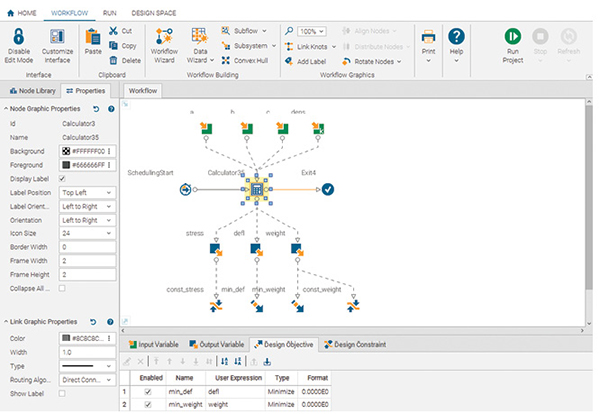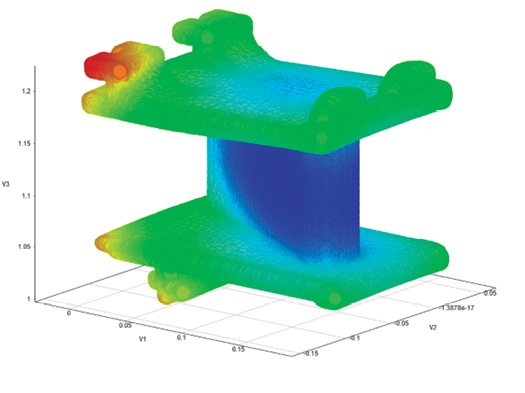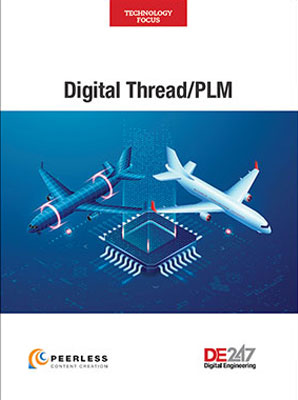Optimize Your Simulation Workflow
A variety of industry tools and platforms aim to streamline workflows to accommodate more advanced analysis and to promote design optimization.

modeFrontier’s workflow optimization capabilities include the ability to execute integration chains, condense large engineering problems into modules and schedule nested optimizations. Image courtesy of ESTECO.
Latest News
November 1, 2018
Rising product complexity is giving way to widespread use of more and varied simulation studies along with model-based system engineering approaches to help engineers zero in on optimal designs far earlier in the process. Despite how instructive pervasive simulation has become, there’s a glitch with capitalizing on tools intended to tackle design complexity—they often introduce another layer of workflow and data integration that adds to the engineering burden while potentially extending out the design cycle.
The industry, recognizing the bottleneck, is serving up a variety of workflow optimization solutions intended to make it easier for engineers to leverage a broad array of tools for complex design of experiments and simulation studies, including manufacturing process simulation. The solutions don’t fit neatly into any single category—they range from multidisciplinary design optimization platforms to workflow optimization and even automation—yet the goal is similar: Make it easier for engineers to manage and solve complex problems, streamlining development time and taking costs out of the equation.

SmartUQ works in conjunction with simulation tools to make the verification of complex systems more manageable. Image courtesy of SmartUQ.
The need for an optimization workflow assist is being driven by complexity, from the standpoint of the product and the requirement for disparate expertise, hailing from different engineering functions and likely from dispersed locales thanks to globalization and extended partner ecosystems. “If workflow is not managed, it’s difficult to get from step A to step B and step C,” explains Craig Resnick, vice president of consulting at ARC Advisory Group. “You need to go through the appropriate inputs, checkpoints and verifications. Otherwise you can go down a wrong detour and add a lot of extra time to the cycle with the potential for more errors and problems.”
The universal industry requirement to accelerate time to market is another reason why the concept of workflow optimization is starting to resonate with engineering organizations. “The speed in which companies need to develop new products is so greatly accelerated today. It’s almost like once a new product is released, it’s back to the drawing board to design whatever is going to replace it,” Resnick says. “You need to hit the ground running or else get run over by a competitor.”
Though the cost of workflow optimization solutions can be a turnoff, especially for smaller engineering organizations, taking the long view of the payoff for the investment may be worth it.
“If your design time takes an extra six months and your time-to-market is delayed, the amount of lost revenue and potential market share can offset the cost of these tools,” says Resnick. “You can’t live in a digital transformation society unless you leverage all the tools, and workflow management is key.”
Platform Diversity
Workflow management or optimization may be increasingly important to the engineering toolbox, but it’s still an emerging concept in an amorphous category, with all sorts of solutions tackling the problem from different angles. Although the approaches and specific objectives may vary, the bulk of workflow optimization offerings focus on simulation because of its prominent role in the engineering cycle and the trend of doing more varied and extensive studies upfront in the design process.
ESTECO, which has worked on this problem for a couple of decades now, positions its modeFRONTIER platform as an environment for process automation and optimization for simulation. The platform integrates with third-party tools and popular simulation programs using design of experiments and optimization algorithms to help drive the search for an optimal result. The platform offers direct nodes that seamlessly connect to popular simulation solvers, allowing engineers to couple multidisciplinary tools and automation, and create a workflow that arrives at an optimal result based on specific constraints and objectives.
In addition to its own workflow engine, ESTECO also supports the Business Process Model and Notification standard, which is adopted by leading industry players as a graphical notation and precise model used to specify business processes. The standard opens up workflow interoperability to a broader spectrum of compatible tools. In addition, modeFRONTIER has a workflow editor used to manage and schedule the simulation runs along with post-processing statistical and analytics tools for making sense of the results.
Process automation and optimization are critical given the growing number of parameters and variables required for modern-design simulation efforts, as well as the shift to systems-level engineering, according to Danilo Di Stefano, ESTECO product manager for modeFRONTIER. Without such tools at their disposal, simulation and design optimization is typically done using a smattering of in-house and third-party CAD and CAE tools, which can result in a disconnected and difficult-to-manage process. Engineering teams typically rely on custom scripts to create a coordinated workflow between disparate tool sets, which further complicates matters and doesn’t allow for consistency, he explains.
“A workflow approach to optimization is the idea of making your work available to other people in a logical way,” Di Stefano says. “Having the workflow displayed in a graphical way on screen gives you the logic of the process, whereas when you look at a script, you don’t have that immediate perception.”
Sigmetrix, a maker of tolerance analysis and geometric dimensioning and tolerancing (GD&T) software, promotes a third-party process integration and design optimization tool as part of its simulation portfolio. The Optimus platform, from Noesis Solutions, has a direct interface to Sigmetrix’s CETOL 6σ, allowing users to fully integrate third-party CAE solutions into a full 3D assembly tolerance analysis for improved product quality and to achieve reductions in manufacturing costs. Optimus’ graphical user interface and workflow engine integrates different simulation codes, automating the process and providing complete visualization, including relevant data and a mapping of all programs involved along with the input and output definitions.
“This kind of simulation workflow allows engineers to bring various tools together to achieve a higher level process to thread different types of analysis together and use an optimization engine to perform iterations,” says James Stoddard, president of Sigmetrix. “We provide an analysis [tool] that can fit in that process.”
SmartUQ has a different take for solving simulation workflow challenges. The company offers commercially packaged uncertainty quantification (UQ) software, which is the science of characterizing and reducing uncertainties in computational and real-world applications. The methodology brings real-world variability and probabilistic behavior problem-solving to systems engineering workflows, helping teams quantify uncertainty with the goal of flagging potential problems that could lead to bad design choices while accelerating design cycles.
SmartUQ works in conjunction with physics-based simulation tools to make complex systems verification more manageable. Most analysis tools aren’t equipped to handle the complexity of large-scale problems, SmartUQ officials contend, which can result in missing data that puts simulation integrity at risk. For example, consider SmartUQ’s role in a design of experiments exercise: It can help minimize the number of design points or simulation runs needed to get meaningful results, explains Mark Andrews, SmartUQ technology steward.
“If you have a large system and you want to try to assemble a huge DOE to cover everything, it’s simply not feasible,” he says. “SmartUQ can intelligently reduce the requirements of the design space, saving time and simulation runs.”
CAE Tools Tackle Workflow
Apart from full-blown workflow optimization platforms, leading simulation tool vendors are also taking steps to simplify and streamline simulation processes. Aras, for example, recently announced a simulation product data management (SPDM) strategy to support higher-volume simulations for complex scenarios (think internet of things and the digital twin) and as part of its plan, acquired Comet Solutions Inc. Aras’ SPDM strategy aims to address its customers’ ongoing challenges related to managing and maintaining simulation as a core part of the mainstream engineering process, according to Marc Lind, Aras’ senior vice president of strategy.
Comet’s software specifically tackles the process piece of simulation management, employing a vendor-agnostic approach through its unified data management model, allowing it to manage mixed fidelity models and different data types. Rather than managing data at the file level like most SPDM systems, the Comet technology extracts intelligence from the simulation model and results. It also sets up tool chain automation that can execute jobs across simulation tools—finite element analysis, computational fluid dynamics or Modelica modeling, for example—allowing engineers to streamline processes for complex analysis while setting up simulation processes for reuse.
“A better tool chain is foundational to higher order processes and initiatives, whether that’s reduction of physical testing or futuristic scenarios like simulating the digital twin,” Lind says. “By acquiring Comet’s unique data modeling capabilities and best-in-class process technology, we get a jumpstart on the P [in SPDM] and are able to do it as part of an integrated workflow.”
Subscribe to our FREE magazine, FREE email newsletters or both!
Latest News
About the Author
Beth Stackpole is a contributing editor to Digital Engineering. Send e-mail about this article to DE-Editors@digitaleng.news.
Follow DE





